(Original unedited text in Japanese follows)
The Pulverer Collection is acknowledged as one of the world’s greatest collections of Japanese illustrated books (ehon) assembled since the end of the Edo period (1615–1868). Dr. Gerhard Pulverer amassed his collection of single-sheet prints, surimono, and paintings between the 1970s and 2000 when he was resident in Cologne, Germany. His principal consultant in their selection was Jack Hillier (1912–1995), a highly respected British scholar and expert of Japanese illustrated books. With Hillier’s advice and assistance, and through negotiations with various booksellers, antique shops, and others, Dr. Pulverer systematically compiled a broad, comprehensive collection of superb quality.
Dr. Pulverer admits that he has always been especially attracted to illustrated books: “Our ukiyo-e collection comprises three areas: prints, books, and paintings, including sketches. Personally, I love the illustrated books the most but this might due to the influence of Mr. Hillier.” 1 It is for that reason that Dr. Pulverer gradually sold many of the prints and other pieces in his collection, barring the illustrated books, after moving to Austria in 2000. He made a concerted effort to avoid the dispersion of his remaining ehon collection and sought a location that would allow it to stay intact. In 2007 the Freer Gallery of Art in Washington, DC purchased the collection.
The Pulverer Collection consists of over 900 illustrated book titles produced between the seventeenth and twentieth centuries, a period spanning the early Edo to Shōwa (1926–1989) periods. Sadly, in Japan there are no comparable collections but well-known public holdings in the field outside the country include the Museum of Fine Arts, Boston, the British Museum, London, and the Art Institute of Chicago. In terms of quality and quantity the Pulverer Collection is equal to the holdings of illustrated books in these institutions, and it is peerless as a collection formed by a private collector.
An examination of the artists represented in the Pulverer Collection reveals the diverse range of artists, not only many figures from the world of ukiyo-e (浮世絵) but also a considerable number from the more official Rinpa (琳派), Maruyama-Shijō (円山四条), and literati (nanga 南画or bunjinga 文人画) lineages. Moreover, the works in the Pulverer Collection reflect the geographic dynamic that existed between urban centers such as Kyoto, Osaka, and Nagoya, which cultivated different tastes and sensibilities to rival the prominence of the capital Edo (present-day Tokyo). The subject matter encountered in the books is similarly myriad, including Chinese and Japanese personages, landscapes, flowering plants, and animals. The ukiyo-e books, in particular, are not simply pictorial collections, rather they are elaborate works that also contain poetry, texts of a pedagogical and historical nature in addition to information on various art forms.
The Birth and Development of Full-Color Woodblock-printed Books
What sets the Pulverer Collection apart from others of its kind is the inclusion of high-quality colored illustrated books dating from the middle to late Edo period. During this time, the main publishers in the “three capitals” (santō 三都) of Kyoto, Osaka, and Edo, as well as Nagoya, engaged celebrated artists to collaborate with literary coteries, such as those associated with haikai and kyōka poetry, calligraphy, licensed pleasure quarters, and theater districts. These publishers built on established target markets, introducing innovative approaches and technologies to compete in the production of illustrated books. Using the rich holdings of the Pulverer Collection, I will attempt to fashion an image of the evolution of Japanese illustrated books of this era.
The first work deserving mention is Minchō shiken (Ōoka Shunboku; 1746), which is based on the 1679 Chinese Qing-dynasty painting album (gafu) Jiezhiyuan hua zhuan 芥子園畫傳 (J. Kaishien gaden; The mustard seed garden manual of painting) by Wang Gai (J. Ō Gai) Fig. 1. Two years later, in 1748, the Kyoto publisher Kōnami Shirobē (河南四郎兵衛; shop name Kōnamirō 河南楼) released the Japanese produced Kaishien gaden. What must surely have surprised the public at this time is the exquisite freshness in the faithful recreation of the original designs, achieved by having adept Kyoto block-cutters and printers join forces to implement the techniques of woodblock printing, stenciling, and hand-coloring. The coloration of Kaishien gafu influenced the later Sō Shiseki gafu Fig. 2 (1765). The vibrancy of the palette in Sō Shiseki gafuharmonizes well with the precise, finely tuned and sensitive carving, while the subjects depicted and the techniques of drawing are based on Chinese painting albums. Although this book was published in Edo, the colophon indicates that block-cutters were brought in from Kyoto for its production.
Notable among the outstanding illustrated books made in Edo are Wakana (Katsuma Ryūsui/Hanabusa Ippō,1756; FSC-GR-780.65) and Umi no sachi Fig. 3 (Katsuma Ryūsui;1762). These two works were privately published by a haikai poetry group. The former marked the seventeenth anniversary commemorating the death of the haikai poet Chōha 超波 (1702–1740), and the latter featured the realistic representation of fish and shellfish as if drawn from nature. Each contained hokku verse (a form subsumed within haikai) from various poets. Both Wakana and Umi no sachi are Edo illustrated books with haikai poetry, and they stand out for their use of color when seen from the perspective of Edo printing technology.
In 1765 the technique of polychrome printing using color woodblocks was developed in Edo. These works came to be known as Azuma nishiki-e (東錦絵), or “Brocade pictures of the East [Edo],” due to the association made with color silk brocades (nishiki).However, the first full-scale commercial application of full-color printing did not appear until 1770 with the publication of Ehon butai ōgi Fig. 4 (1770), a joint work by Katsukawa Shunshō and Ippitsusai Bunchō. Ehon butai ōgi is a collection of kabuki actors “likenesses” (nigao-e) of the three cities of Edo, Kyoto, and Osaka, and its richly colored, detailed actor portraits were positively received by theater fans. Interestingly, this work was originally published as a private publication by the Edoza group of haikai poets. 2 Also released in the same year was Ehon seirō bijin awase Fig. 5 (Suzuki Harunobu; 1770), in which hokku verses accompanied the “likenesses” of courtesans from different brothels of the Yoshiwara licensed district. Like Ehon butai ōgi, this book is also believed to have been produced and financed by a haikai group.
The year 1770 additionally witnessed the publication of Shokunin burui Fig. 6 (Tachibana Minkō) in Edo. A second edition was subsequently issued, offering us a glimpse into the popular tastes of the times. It is important to note that this book was a collaboration between the Osaka artist Tachibana Minkō, or at least a specialist Osaka printer, who provided the stenciling technique, and the Edo-based Okamoto Shōgyo 岡本松魚 (dates unknown), who produced the detailed block carving. This demonstrates that even after the development of full-color woodblock printing, the stenciling technique associated with Osaka and the Kansai region continued to be highly regarded.
From Shunshō to Utamaro
Following Suzuki Harunobu’s Ehon seirō bijin awase was Seirō bijin awase sugata kagami Fig. 7 (Katsukawa Shunshō/Kitao Shigemasa; 1776). In addition to the illustrations of courtesans in this work are select pages containing only verse. Each courtesan illustrated contributed a poem, and it has been conjectured that the brothel owners or haikai poets may have contributed financially to the project.Shunshō had already established a solid reputation primarily as an artist of bijin, or “beautiful women.” His books Nishiki hyakunin isshu azumaori (1775; FSC-GR-780.160) and Sanjūrokkasen Fig. 8 (1789) combined waka poetry with kasen-e 歌仙絵 (pictures of the “Immortal Poets,” or kasen). Nishiki hyakunin isshu azumaori was initially published with calligraphy by Shunshō in the style of Fujiwara no Teika 藤原定家 (1162–1241) and later revised with calligraphy in the style of Sayama Eiroku 猨山叡麓 (d. 1780). In 1786 Shunshō collaborated once again with Shigemasa on Ehon takara no ito (FSC-GR-780.168), which illustrated the process of sericulture. Almost a decade later, in 1795, he published Ehon matsu no shirabe (FSC-GR-780.159.1-2)that joined images with the lyrics from koto music.Both Ehon takara no ito and Ehon matsu no shirabe deal with the well-grounded topic of women’s education. Moreover, these two works had the series of single-sheet woodblock prints that were produced in advance before the book was bound.
A few years later Shin bijin awase jihitsu kagami Fig. 9 (Kitao Masanobu; 1784) followed Seirō bijin awase sugata kagami. This album anticipated the demand for handwritten calligraphy by introducing the novel idea of adding waka verse based on the courtesans’ own calligraphy. Also noteworthy is that this book is bound using the gajosō, and not fukurotoji, form of binding. In the “album,” or gajosō, type of binding the printed sheet is folded inward and pasted along the outside vertical edges to the back of the next sheet. Potentially, this type of binding could accommodate changes made to a single printed image. Masanobu designed other books such as Azumaburi kyōka gojūnin isshu (1786; FSC-GR-780.331) and Kokon kyōka bukuro (1787; FSC-GR-780.332). The primary focus of these two works was the subject of the so-called Tenmei-era (1781–1789) kyōka poets: a single kyōka poem accompanied an iconic portrait in a kasen-e style. Many similar works adopting this model would subsequently follow.
In the same year, that is 1787,Torii Kiyonaga designed the Saishiki mitsu no asa Fig. 10, which depicted an entire era of bijinga (pictures of beautiful women). At this time the publisher Tsutaya Jūzaburō 蔦屋重三郎 (Kōshodō 耕書堂; 1750–1797) became the most influential figure in the world of publishing (books and full-color prints). 3 Tsutaya promoted the artist Kitagawa Utamaro from the last year of the Tenmei era (1789) into the early Kansei era (1789–1801); Utamaro became renowned, like Kiyonaga, for his portrayals of beautiful women. Utamaro’s first work with Tsutaya was the sumptuously produced Ehon mushi erami Fig. 11 (1788). In addition to the exceptional coloration, it employed techniques such as embossing or blind-printing (karazuri), and the application of mica and gold lacquer. It also had the kyōka poems cut into the blocks of the images rather than presented as separate pages, integrating poetry with illustration.Other color woodblock-printed books by Utamaro, including the 1789 Waka Ebisu (FSC-GR-780.323), Shiohi no tsuto (FSC-GR-780.324),and Kyōgetsubō (FSC-GR-780.322), as well as Gin sekai (1790; FSC-GR-780.318), were released in rapid succession. While their subject matter might vary, they are similar in their incorporation of kyōka verse and were sponsored by the poets.
Surimono and Publishing Controls
In 1790 the Tokugawa shogunate promulgated draconian censorship edicts regarding publishing. One of its targets was “luxurious” productions and for a short period publishers stopped printing color woodblock-printed books in accordance with the edicts. Perhaps the first instance in which publishers broke the practice of self-censorship was in 1793 with the release of Utagawa Toyohiro’s Michinokugami kyōka-awase (FSC-GR-780.735). Then, in 1794 and 1795 two kyōka bound albums entitled Haru no iro (FSC-GR-780.847/FSC-GR-780.848) were issued on the theme of spring. The editor and compiler of this book, Tsumuri no Hikaru (1754–1796), succeeded Yomo no Akara (Ōta Nanpo) as leader of the kyōka group Hakuraku-ren. The Haru no iro volumes were collaborative works involving a number of artists, including Kubo Shunman, Tsutsumi Tōrin, Suzuki Rinshō, and Tawaraya Sōri (Katsushika Hokusai): all of these individuals were primarily active in the world of surimono. Also participating were established ukiyo-e artists such as Kitao Shigemasa and Kitagawa Utamaro. Together, they vied with each other in terms of beauty and skill that went beyond stylistic schools.
Also concurrent with Haru no iro were the kyōka books entitledYomo no haru Fig. 12, which were compiled by the Sukiya-ren, a kyōka group spearheaded by another poetry master, Shikatsube no Magao (1753–1829), and published annually by Tsutaya Jūzaburō. The Pulverer Collection has a 1795 edition of this work, to which the artists Kitao Masayoshi (Kuwagata Keisai), Suzuki Rinshō, Sō Shizan, Santo Kyōden, Watanabe Gentai, and others contributed. These illustrations convey the refined, elegant realm that was in keeping with surimono and seem to mark a zenith among color woodblock-printed books. The bound albums Momo saezuri (1796; FSC-GR-780.385) and Hakuraku shū (1797; FSC-GR-780.852) serve as a bridge between the death of Hikaru in 1796 with the stepping in of editor Asakusa no Ichihito (Asakusa’an Ichihito; 1755–1821) with works such as Otoko tōka (1798; FSC-GR-780.853).
From the late Kansei until the last year of the Kyōwa era (1801–1804), the most prominent names in the sphere of color woodblock-printed books were Kitao Masayoshi and Katsushika Hokusai. In 1787 the Kyoto publisher Yoshinoya Ihachi (Eishōdō栄昌堂)—already successful with his publications of meisho, or “famous places”—released Masayoshi’s Ehon miyako no nishiki (FSC-GR-780.344). However, Masayoshi’s most popular illustrated books were clearly those executed in an “abbreviated drawing or sketch style” (ryakuga shiki 略画式), including Ryakuga shiki Fig. 13 (1795), Chōjū ryakuga shiki (1797; FSC-GR-780.342), Jinbutsu ryakuga shiki (1799; FSC-GR-780.336), and Sansui ryakuga shiki (1800; FSC-GR-780.337). They are typical model books (edehon), but their coloration is limiting in the number of colors and to the use of light colors. In 1802 he published the Tatsu no miyatsuko (FSC-GR-780.338),an album depicting fish and shellfish with accompanying poems. It was then re-published under the title Gyokaifu and subsequently as Gyokai ryakuga shiki without the names of the poets. Ultimately, all of the poems were removed but this does not detract from the spirit of the work.
Hokusai, already by this period accomplished in the world of surimono and commercial prints, continued to design color woodblock-printed illustrated books of famous places (meisho) in Edo such as Tōto shōkei ichiran (1801; FSC-GR-780.217.1-2), Ehon kyōka yama mata yama (1804; FSC-GR-780.236.1-3), and Ehon Sumidagawa ryōgan ichiran Fig. 14 (undated). These workssolidified his popularity as well as that of books dealing with Edo meisho. The influence of his work in this category of books was Ehon azuma mono mōde (1804; FSC-GR-780.800) with illustrations by Utagawa Toyohiro and text by Nansenshō Somabito.
Illustrated Books by the Utagawa Lineage and Other Ukiyo-e Artists
in the Early Nineteenth Century
Ukiyo-eartists associated with the Utagawa school gained influence during the early years of the nineteenth century.Utagawa Toyokuni I was the most significant of these, and themes relating to the kabuki theater represent a significant portion of his illustrated books. Toyokuni’s work in this area include Yakusha sangaikyō Fig. 15 (1801) with text by Shikitei Sanba and offer a glimpse into the theater’s “third floor” (gakuya 楽屋), a term for the backstage. Other works include Yakusha konotegashiwa (1803; FSC-GR-780.744.1-2) with text by Utei Enba (1743–1822), depicting kabuki actor“likenesses,”and Yakusha awase kagami (1804; FSC-GR-780.747) with text by Asakusa no Ichihito, featuring ōkubi-e (bust portraits) of kabukiactors.Shibai kinmō zui (1803) with text by Sanba is another important work, a collaboration between Toyokuni and Katsukawa Shun’ei. The first printing of this work is in color but the copy in the Pulverer Collection is a later 1806 monochrome printing (FSC-GR-780.157.1-5). With the exception of Yakusha awase kagami, these illustrated theater books partnered noted writers of popular fiction (gesaku) in the same manner as books of popular literature such as hanashibon and kokkeibon. Other color woodblock-printed books by Toyokuni from 1802 are Ehon imayō sugata (1802; FSC-GR-780.742.1-2/1916 facsimile printing FSC-GR-780.743.1-2), with illustrations by Toyokuni and text added by Sanba, and Yūshi kego (FSC-GR-780.738), the illustrations a collaborative effort with Utagawa Toyohiro and the text by Sakuragawa Jihinari. During this era Kitagawa Utamaro regained his standing as an artist of illustrated books with the release of the image-only Ehon shiki no hana (1801; FSC-GR-780.325.1-2)and the Seirō ehon nenjū gyōji Fig. 16 (1804) with text by Jippensha Ikku. The Pulverer Collection includes both the color (FSC-GR-780.327.1-2) and monochrome (FSC-GR-780.319.1-2) printings of Seirō ehon nenjū gyōji. Judging from the detailed rendering of the lines, it could be conjectured that from the onset this work was equally designed to be appreciated in monochrome.
Color Woodblock-Printed Books Featuring Bunjinga, Rinpa, and Calligraphy
Beautifully executed color illustrated books from different artistic (painting) lineages were also produced during this period. Haikai sanjūrokkasen (Yosa Buson, 1799; FSC-GR-780.793) as well as the 1803 works Katsura kasane (Matsuya Nichōsai; FSC-GR-780.411) and Kishi enpu (Saitō Shūho; FSC-GR-780.549.1-3) are ingenious, tastefully illustrated haikai books that were issued through the regular financial support of haikai fans. Also released at this timewas Nishiki zuri onna sanjūrokkasen (ChōbunsaiEishi, 1801; FSC-GR-780.99.1-2),which gathered together calligraphic works by thirty-six female students associated with the Hanagata lineage of calligraphy to accompany images of the “Thirty-six Immortal Female Poets” (onna sanjūrokkasen 女三十六歌仙). The Kōrin gafu (Nakamura Hōchū, 1802; FSC-GR-780.436.1-2) attempts to recreate in printed form the use of the painting technique by Ogata Kōrin 尾形光琳 (1658–1716) called tarashikomi (たらし込み), or “dripping in,” in which a second layer of paint is applied before the first layer is dry. The album Shūchin gajō (1803; FSC-GR-780.113.1-2), redesigned by Ishikawa Tairō, assembled and scaled down original paintings by Kano Tanyū 狩野探幽 (1602–1674)and others; it also employed some color stenciling. The color washes in the album Shōkadō gajō (Shōkadō Shōjō, 1804; FSC-GR-780.542) were handled in such a way so as to give the impression of monochrome ink painting, and the backgrounds appear almost as if they are yūzen-style textiles.
Light Color Printing and the Ban on Color Printing
The shock (and the severity) of the Tokugawa shogunate’s ban on color printing was such that publishers continued the practice of self-censorship until 1817. During this period published works were produced in gray scales. Although the ban was strictly adhered to in Edo—the seat of the Tokugawa shogunate—private publications such as erotic books, books of the New Year, surimono, and illustrated calendars (egoyomi) managed to skirt the regulations. Moreover, there were some indications that the law was not always enforced in the Kyoto-Osaka (Kamigata) region. Examples include the album of kabuki actor “likenesses,” Masu kagami Fig. 17 (Shōkōsai Hanbē; 1806), and Bijin awase (1807; FSC-GR-780.856), an illustrated book by Watanabe Nangaku and other artists of Shijō lineage with accompanying poems.
The ban on color printing seems to have been gradually alleviated as evinced by the restricted use of light colors, which resulted in works with an overall softer palette. In the works in the Pulverer Collection the beginning of this trend is seen in Bokusen gafu (Maki Bokusen, 1809; FSC-GR-780.394.1-2), followed by Kaidō kyōka awase Fig. 18 (1811) with images by Watanabe Nangaku and Kawamura Bunpō and text by Ueda Akinari, and finally Koga yōran (Hasegawa Settan, 1812; FSC-GR-780.70). The latter reproduced the world of painting using gray tones, with occasional accents of color, and as such was similar in feel to the aforementioned Shōkadō gajō.
The first volume of Katsushika Hokusai’s Hokusai manga was released in 1814, and the continued publication of further volumes of this title seemed to have encouraged other publishers to issue books employing a more subdued palette. Representative works include Manga hyakujo (Aikawa Minwa, 1814; FSC-GR-780.33) and Fukuzensai gafu (Niwa Shaan, 1814; FSC-GR-780.467.1-6); Kengo hinrui zukō (Niwa Tōkei, 1815; FSC-GR-780.468); the 1816 Santai gafu (Hokusai; FSC-GR-780.238) and Kyōchū zan (Kameda Bōsai; FSC-GR-780.137); Fukei gasō (Chō Gesshō, 1817; FSC-GR-780.47/ FSC-GR-780.48); and Kōrin gashiki (Minwa, 1818; FSC-GR-780.34).These titles show various adaptations for printing with lighter colors. In the case of Hokusai manga Fig. 19 (1814–1878), for example, the compositions are simply conceived with the addition of gray and rose pink tones to the black sumi ink key block, or “main block” (omohan). This approach to printing color considerably reduced labor costs and production time.
Multicolored books also gained new life in the face of the easing of the ban on color printing, and perhaps a pioneering work in this regard was Hokusai shashin gafu Fig. 20 (1814). This title is missing a publisher’s mark. However, Taira no Yuzuru 平由豆流 (Kishimoto Yuzuru 岸本由豆流; 1788–1846) wrote the preface to Hokusai shashin gafu, and this suggests that he might have been the publisher. Kishimoto also wrote the preface to Kitao Masayoshi’s Sōka ryakuga shiki (1813; FSC-GR-780.341). Other works where the preface writers were the likely publishers are Shazanrō gahon (1816; FSC-GR-780.602) and Ōson gafu (1817; FSC-GR-780.516). Both albums were by influential artists, Tani Bunchō and Sakai Hōitsu, respectively, and include their art names (Shazanrō and Ōson) in the book titles. Although there are earlier examples of the use of the name Hokusai in the book title, the more frequent use of the artist’s name in the title at this time became more prevalent, perhaps functioning to market the books on offer.
As discussed above, these multicolored books published between 1813 and 1817 demonstrate a deliberate restricted use of color, yet these works were of a high aesthetic quality. It was perhaps not until 1817 that publishers again produced multicolored books with confidence as seen in works on the kabuki theater. Kabuki actor “likenesses” thus spurred the departure from the production of books in mostly gray scales such as Yakusha nigao haya geiko Fig. 21 (1817) to a return to full color—that is, the energy generated by the popularity of kabuki was enough to overcome the problems surrounding legal prohibitions and production costs. This, in turn, infused renewed life into full-color illustrated books. The ban on color printing had now been effectively removed and color-printed books once more restored to their glory.
Selected readings:
Akama Ryō赤間亮, Zusetsu: Edo no engekisho: kabuki hen『図説江戸の演劇書歌舞伎篇』(Tokyo: Yagi Shoten, 2003).
Asano Shūgō and Timothy Clark, The Passionate Art of Kitagawa Utamaro (Tokyo: Asahi Shinbun; London: Trustees of the British Museum, 1995).
Timothy T. Clark and Osamu Ueda with Donald Jenkins, The Actor’s Image: Print Makers of the Katsukawa School (Chicago: Art Institute of Chicago, 1994).
Julie Nelson Davis, Partners in Print: Artistic Collaboration and the Ukiyo-e Market (Honolulu: University of Hawai‘i Press, 2015).
Fujisawa Murasaki藤澤紫, Suzuki Harunobu ehon zenshū『鈴木春信絵本全集』/ The Complete Works of Suzuki Harunobu’s Picture Books (Tokyo: Bensei Shuppan, 2003).
Jack Hillier, The Art of Hokusai in Book Illustration (London: Sotheby Parke Bernet and Berkeley: University of California Press, 1980).
Jack Hillier, The Art of the Japanese Book, 2 vols. (London: Sotheby’s Publications by Philip Wilson Publishers Ltd., 1987).
Ishikawa Ryō石川了, Edo kyōkadan shi no kenkyū『江戸狂歌壇史の研究』( Tokyo: Kyūko Shoin, 2011).
Roger S. Keyes, Ehon: The Artist and the Book in Japan (The New York Public Library in association with the University of Washington Press, 2006).
Kokusai Ukiyo-e Gakkai国際浮世絵学会, ed., Ukiyo-e daijiten『浮世絵大事典』(Tokyo: Tōkyōdō Shoten, 2008).
C. H. Mitchell, with the assistance of Osamu Ueda, The Illustrated Books of the Nanga, Maruyama, Shijo and Other Related Schools of Japan. A Biobibliography (Los Angeles: Dawson’s Book Shop, 1972).
Nakada Katsunosuke仲田勝之助, Ehon no kenkyū『絵本の研究』(Tokyo: Bijutsu Shuppansha, 1950).
Nakano Mitsutoshi中野三敏, ed., Edo no shuppan『江戸の出版』(Tokyo: Perikansha, 2005).
Nakano Mitsutoshi中野三敏and Kikutake Jun’ichi 菊竹淳一, eds.,Ehon gafu nenpyō「絵本画譜年表」, vol. 5 (1998), Aimi Kōu shū『相見香雨集』, Nihon shoshigaku taikei 45『日本書誌学大系45』(Musashimurayama-shi: Seishōdō, 1985–1998).
Narasaki Muneshige楢崎宗重, ed., Puruverā korekushon 「プルヴェラー・コレクション」, vol. 14 (1990), Hizō ukiyo-e taikan『秘蔵浮世絵大観』, 16 vols. (Tokyo: Kōdansha, 1987–1991).
Suzuki Jun鈴木淳, and Asano Shūgō浅野秀剛, eds., Edo no ehon gazō to tekisuto no ayanaseru sekai『江戸の絵本画像とテキストの綾なせる世界』/ Ehon in the Edo Period: A Splendid World of Interwoven Image and Text(Tokyo: Yagi Shoten, 2010).
Suzuki Jun, and Ellis Tinios, Understanding Japanese Woodblock-Printed Illustrated Books: A Short Introduction to Their History, Bibliography and Format (Leiden and Boston: Brill, 2013).
Suzuki Jūzō鈴木重三, Ehon to ukiyo-e 『絵本と浮世絵』(Tokyo: Bijutsu Shuppansha, 1979).
Kenji Toda, Descriptive Catalogue of the Japanese and Chinese Illustrated Books in the Ryerson Library of the Art Institute of Chicago (Chicago: 1931; repr., Mansfield Centre, CT: Martino Publishing, 2004).
プルヴェラ-コレクションとその色摺り絵本の世界
プルヴェラー・コレクションとは】
ゲルハルト・プルヴェラ-旧蔵の絵本類は、日本の江戸時代以降の一大コレクションとして、世界的に知られた存在である。本コレクションは、プルヴェラ-氏が、一九七〇年代から二〇〇〇年にかけて、ドイツのケルン市に在住し、版画、摺物及び肉筆画などと共に構築に努めてきたものである。蒐集は、主として英国の日本絵本の研究者また鑑定家として著名なジャック・ヒリアーの助言を受けながら、欧米や日本の古書籍商、古美術商を通じて、体系的、網羅的に行われた。
プルヴェラ-氏自身、「私たちの浮世絵コレクションは版画、絵本、肉筆画とスケッチの三分野から成っています。私自身は最も絵本が好きですが、これもヒーリア氏の影響を受けたためといえるでしょう」(『秘蔵浮世絵大観』序文)という通り、特に絵本に愛着を持っていた。そのため氏は、故国のオーストリアに移住する二〇〇〇年前後に、板画、その他のコレクションを徐々に手放すに至ったが、最後に残された絵本については、散逸を避け、まとまった形での受け入れ先を探し求めた結果、二〇〇七年、最終的に米国スミソニアン協会フリーア・ギャラリー・オブ・アーツの有に帰したのである。
集められた絵本は、十七世紀から二十世紀、すなわち江戸時代初期から昭和期に到る、約九四〇点を数える。日本国内にはこれに匹敵するものはなく、国外の絵本コレクションとしては、ボストン美術館、大英博物館、シカゴ美術館などが知られている。本コレクションは、質量ともこれらに並び、個人の蒐集になるものとしては、世界最大級という名に恥じない。
画系から見ると、浮世絵系が多いことはもとより、琳派、円山四条派、南画などの本画系の絵師も少なくない。地域的には、江戸を中心としながら、京都、大坂などの上方と名古屋がそれに拮抗し、それぞれ異なる風趣を自己主張している。また画題についていえば、和漢の人物、風景、草花、動物の広汎な領域に及ぶことはもちろん、とくに浮世絵師による絵本は、単なる絵画の集成というより、詩歌、教訓、故事、諸芸などのテキストを伴った複合的な作品というべきものが多い。
【本格的色摺り絵本の誕生】
本コレクションの特色を際立たせているのは、江戸時代中期から後期に至る質の高い色摺り絵本の存在であろう。この時期は、三都や名古屋の主立った板元が、著名な絵師を起用し、俳諧、狂歌、書道、遊里、劇場界などの文芸、芸能のコミュニティと連携して、確立された販路の上に、創意工夫と技術を凝らし、競うように絵本を出していた。いまその色摺り絵本の流れについて、コレクションの範囲の中で、私見を述べたい。
まず挙げるべきは一七四六年、大岡春卜模『明朝紫硯』であるが、本画譜が基づくところは、中国清代の王概編の画法書『芥子園画伝』であり、一七四八年には、京都の板元がその和刻本を出板する。両画譜が世の中を驚かせたのは、原本の忠実な再現を意図して、彫工、摺工を動員し、板摺り、合羽摺り、手彩色の技術を併用して実現させた賦彩のえもいわれぬ鮮やかさである。また『芥子園画伝』の彩色の影響を受けた一例は、一七六五年の『宋紫石画譜』で、彩りの鮮やかさと彫りの繊細さが同居し、画題、画法とも中国画譜を基本とする。出板地は江戸であるが、刊記丁に、京都の彫工を呼び寄せて板刻に及んだことを記す。
江戸の目立った絵本には、一七五六年、勝間龍水・英一蜂画『わかな』と一七六二年、龍水画『海の幸』がある。二点とも俳諧仲間によるプライベート出板と見做され、前者は超波十七回忌追善を謳い、後者は写実的な魚類図で、いずれも諸家の発句を添える。江戸で制作された絵俳書であるが、単純な板摺りとは異なり、江戸の色摺りの技術から見ると、その孤立性が際立っている。
一七六五年には、江戸で色板による多色摺りの技術が確立するが、色摺り絵本の本格的始発は一七七〇年、勝川春章・一筆斎文調画『絵本舞台扇』である。本絵本は、三都の役者の似顔絵集で、精細な顔貌の写しに彩りを加え、歌舞伎ファンの溜飲を下げたが、本来は江戸座の俳諧仲間によるプライベート出板とされる。次いで同年の鈴木春信画『絵本青楼美人合』は、妓楼ごとに番われた遊女の姿絵に、発句を添えたもので、本絵本も当初は俳諧仲間の入銀によって出板されたと目されている。
また同年、橘岷江画『彩画職人部類』が江戸で出板され、のち再板も出るなど、時好に投じた痕が窺える。注意すべきは、岷江が大坂の絵師であることから、本絵本は、岷江もしくは上方の摺工による合羽摺りと、江戸の彫工岡本松魚の精密な刻板との合作であることで、色板による多色摺りが普及した後も、上方の合羽摺りが尊重された事実を物語る。
【春章から歌麿へ】
春信の『絵本青楼美人合』を嗣いだのが、一七七六年、勝川春章と北尾重政の合作『青楼美人合姿鏡』である。遊女の姿絵の他に、発句だけの丁を有し、やはり俳諧仲間の入銀があったことを想像させる。春章はこの頃、主に肉筆画を通じて、美人画においても不動の位置を得ており、一七七五年に『錦百人一首あつま織』、一七八九年に『三十六歌仙』を出した。いずれも歌仙絵に和歌を組み合わせたもので、前者は、はじめ春章自身の定家様の書で出されながら、のち猨山流の書に改刻された。さらに春章には、一七八六年、養蚕の工程について、やはり重政と合作した『絵本宝能縷』と、一七九五年、箏の組曲の歌詞と組み合わせた『絵本松のしらべ』がある。いずれも女性の教養に関わる手堅い画題を扱っている。また両本の共通点として、冊子以前に一枚摺り板画が先行していた事実が指摘されている。
『青楼美人合姿鏡』を継ぐのが、一七八四年、北尾政演画『新美人合自筆鏡』である。新趣向として、遊女の筆蹟に基づく和歌讃を添え、書跡の需要を当て込んでいたことが窺われる。また、本絵本は袋綴本ではなく、画帖装であることも注意すべきである。画帖装は、谷折りした板画を一枚ずつ貼り合わせた形態と見ることができ、潜在的に一枚摺り板画への変換が可能な形態である。政演は、ほかに一七八六年の『吾妻曲狂歌文庫』と翌年刊の『古今狂歌袋』を出した。いずれも、いわゆる天明狂歌の作者を中心に取り上げ、歌仙絵のやつしとしての姿絵に、その狂歌を添えたもので、以後、多くの類似作品が続いた。
同じ一七八七年、美人画の一時代を画した鳥居清長の『彩色美津の朝』が出るが、ついで天明末年(1788)から寛政初期にかけて、この時期の重要な板元である蔦屋重三郎が起用した代表的な画工も、やはり美人画を得意とした喜多川歌麿であった。始まりは、一七八八年の『画本虫撰』で、極彩色に加えて空摺り、雲母引き、金銀蒔きなどの技術を駆使した豪華本であると同時に、狂歌を各絵に彫り入れるという様式を備えている。歌麿の色摺り本は、他に一七八九年『絵本和歌夷』、同『潮干のつと』、同『狂月坊』、一七九〇年『絵本銀世界』などが矢継ぎ早に出た。画題は様々であるが、すべて狂歌を伴うところに特色がある。
【出板取締と摺物との融合】
ところが、一七九〇年に厳しい出板取締令が布達され、しばらく色摺り本が地を払うこととなる。板元の自粛が破られるのは、一七九三年、歌川豊広画『陸奥紙狂歌合』が最初であろうか。続いて、一七九四年と翌年に、『春の色』と題する、春興合作絵入り狂歌本が出板された。撰者は、四方赤良(大田南畝)の後を継ぎ、伯楽連を率いた頭光である。画工には、窪俊満をはじめ、堤等琳、鈴木隣松、俵屋宗理(北斎)ら主に摺物の世界で活躍していた絵師に、重政や歌麿などの確立した浮世絵師も加わり、たがいに流儀を越えて美と技を競った。
絵は、摺物と地続きの高雅にして瀟洒な世界で、色摺り本の一頂点を極めた観がある。この試みは、一七九六年の『百さへつり』、翌年の『伯楽集』と、光の死をまたぐように引き継がれ、一七九八年の『男踏歌』では、撰者が、浅草市人に取って代わった。また『春の色』と同時期、もう一方の領袖、鹿津部真顔が率いる数寄屋連によって、同じく蔦重から連年、出された絵入り狂歌本が『四方の巴流』で、本コレクション本は、その一七九五年板である。画工は、鍬形蕙斎(北尾政美)、鈴木隣松、宋紫山、山東京伝(北尾政演)、渡辺玄対その他である。
寛政期の後半以降、文化元年(1804)にかけて、色摺り絵本の世界で目立った存在は蕙斎と北斎である。蕙斎は一七八七年に、名所図会出板の実績のある京都吉野屋為八などから『絵本都の錦』を出すが、彼の絵本でもっとも人気が高かったのは、一七九五年『略画式』、一七九七年『鳥獣略画式』、一七九九年『人物略画式』、一八〇〇年『山水略画式』などの一連の略画式である。その本質は典型的な絵手本であるが、賦彩は色数を抑え、淡色を用いている。一八〇二年には『龍の宮津子』という発句入りの魚介譜を出すが、次いで作者名を省いた「魚貝譜」、さらに発句を削除した「魚貝略画式」へと改題、修訂を繰り返しながら命脈を保った。
すでに摺物、板画で実績を積んでいた北斎は、一八〇〇年『東都勝景一覧』(初名「東都名所一覧」)、一八〇四年『画本狂歌山満多山』、一八〇四年板刻かと推定される『絵本隅田川両岸一覧』などの色摺り江戸名所絵本を続刊するが、このことは、当時の江戸名所絵本と北斎の人気を証明する。その影響を受けたものの一つに、一八〇四年、歌川豊広画、南仙笑楚満人作『絵本東物詣』(初名「絵本東わらは」)がある。
【歌川派の絵本と本画師の絵本】
また、この時期は、歌川派の浮世絵師の活躍も目立つ。代表は、初世歌川豊国で、歌舞伎関係の絵本が大半を占める。たとえば一八〇一年、「三階」(楽屋)を扱った式亭三馬作『俳優三階興』、一八〇三年、役者似顔絵集の烏亭焉馬述『役者此手嘉志和』、一八〇四年、狂歌入り大首役者似顔絵集の浅草市人作『役者相貌鏡』など、すべて豊国が絵筆を揮った。さらに一八〇三年、勝川春英と合作した三馬作『戯場訓蒙図彙』の初摺りは色摺りであるが、本コレクション本は一八〇六年の求板の墨摺りである。『役者相貌鏡』を除くと、いずれも人気の戯作者と組んで、咄本、滑稽本などの体裁を採る、戯作がかった芝居絵本である。豊国の色摺り本には、このほか一八〇二年、豊国作、三馬閲の付文を添えた『絵本時世粧』、同じく豊広との合作で、慈悲成作『遊子戯語』がある。また、絵本画工としての歌麿も復活し、一八〇一年、絵だけの絵本『絵本四季花』、一八〇四年、十返舎一九作『青楼絵本年中行事』を出した。本コレクションには、後者の色摺りと墨摺りの両様を所蔵するが、その線描の精細さから推して、はじめから墨摺りでの観賞に堪えうる描画を用意したと考えられる。
一方、本画師による雅趣溢れる色摺り絵本の、地域を超えた企画も見られた。まず一七九九年、蕪村画・編『俳諧三十六歌僊』、一八〇三年、松屋耳鳥斎画『かつらかさね』、同年、斎藤秋圃画『葵氏艶譜』などは、素朴な雅趣に富んだ絵俳書で、俳諧愛好者の底堅い支持を受けての板行である。一八〇一年、花形流を学ぶ子女による書跡を集めた、鳥文斎栄之画『錦摺女三十六歌仙』もこの時期であり、一八〇二年、中村芳中模『光琳画譜』では、尾形光琳のたらし込みの画技の再現が試みられた。狩野探幽など本画師の原画を縮約、集成した粉本集である一八〇三年、石川大浪再模『聚珍画帖』は、合羽摺りによる賦彩を含む。また一八〇四年、松花堂昭乗原画『松花堂画帖』は、彩色を交えながら、観る者に墨絵のような印象を与える画帖で、背後に友禅染の織物が控えているように見える。
【色摺りの禁令と淡色摺り】
ところがまた、一八〇四年に幕府から色摺りの禁令が触れ出され、その苛烈な弾圧による衝撃が大きかったこともあり、板元による色摺りの自粛は文化末年まで続く。その間、あらゆる出板物がモノクロームの世界に染まることになった。ただし、幕府お膝元の江戸では制禁が厳格に実施されたが、春本、歳旦帖・春興帖、摺物、大小暦などのプライベート出板は例外であったし、上方では必ずしも徹底されていなかったふしがある。その例として、一八〇六年、松好斎半兵衛画の役者似顔絵本『ますかがみ』、一八〇七年、渡辺南岳ほか四条派絵師画の発句入り絵本『美人合』などがある。
色摺りの制禁は、色合いを抑制的な淡彩色によって徐々に緩められていったが、その始まりは、本コレクションの範囲でいえば、一八〇九年、牧墨仙画『墨仙画譜』である。ついで、一八一一年、渡辺南岳・河村文鳳画、上田秋成著『海道狂歌合』、一八一二年、長谷川雪旦画『古画要覧』が続く。後者は、墨色を基調に、肉筆画の世界を再現したもので、『松花堂画帖』の味わいに通ずる。さらに一八一四年には、『北斎漫画』初編が出され、以後、延々と続刊するに至り、他の淡彩画の板行にも拍車がかかった。代表的なものを挙げると、一八一四年、合川珉和画『漫画百女』、同年、丹羽謝庵画『福善斎画譜』、一八一五年、丹羽桃渓画『牽牛品類図考』、一八一六年、北斎画『三体画譜』、同年、亀田鵬斎画『胸中山』、一八一七年、張月樵画『不形画藪』、一八一八年、合川珉和画『光琳画式』といったところである。淡色摺りといってもさまざまで、『北斎漫画』の場合、基本的には墨の主板に鼠色(薄墨)、肉色を加えた計三板の、至って簡素な構成であり、経費や手間暇も多色摺りよりよほど軽減できた。
もちろん多色摺り本も、その解禁に向けて徐々に動き出ていた。その先駆けは、一八一四年の『北斎写真画譜』あたりか。当絵本は書肆の標記がなく、序者岸本由豆流の道楽出版といわれるが、由豆流は、前年の『草花略画式』にも序を添えている。さらに一八一六年、谷文晁画『写山楼画本』、一八一七年、酒井抱一画『鶯邨画譜』が続く。どちらも有力絵師の画譜で、書名に「写山楼」「鶯邨」と生存絵師の雅号を冠称する。すでに「北斎」の先例があるとはいえ、この頃に顕著に現れた事象といえる。
文化十年代に出された多色摺り本は、色合いを抑え、上品な体裁に仕立てられ、しかも蔵板物の内実が透けて見える。つまり、多色摺り本とはいえ、なお限定的なものであった。書肆が板元として堂々と多色摺り絵本を出すのは、おそらく一八一七年、豊国画『役者似顔早稽古』あたり以降であろう。モノトーンの世界からの出口が、役者似顔絵本であったということは、芝居人気のエネルギーが、取締や経費の問題を抑え込んで、多色摺りを再来せしめたことを意味していよう。
Footnotes
Narasaki 1990, 12.
See Murasaki 2003.
See Ishikawa 2011.
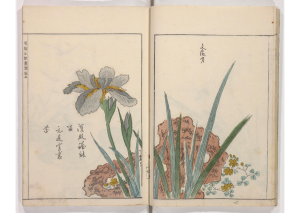
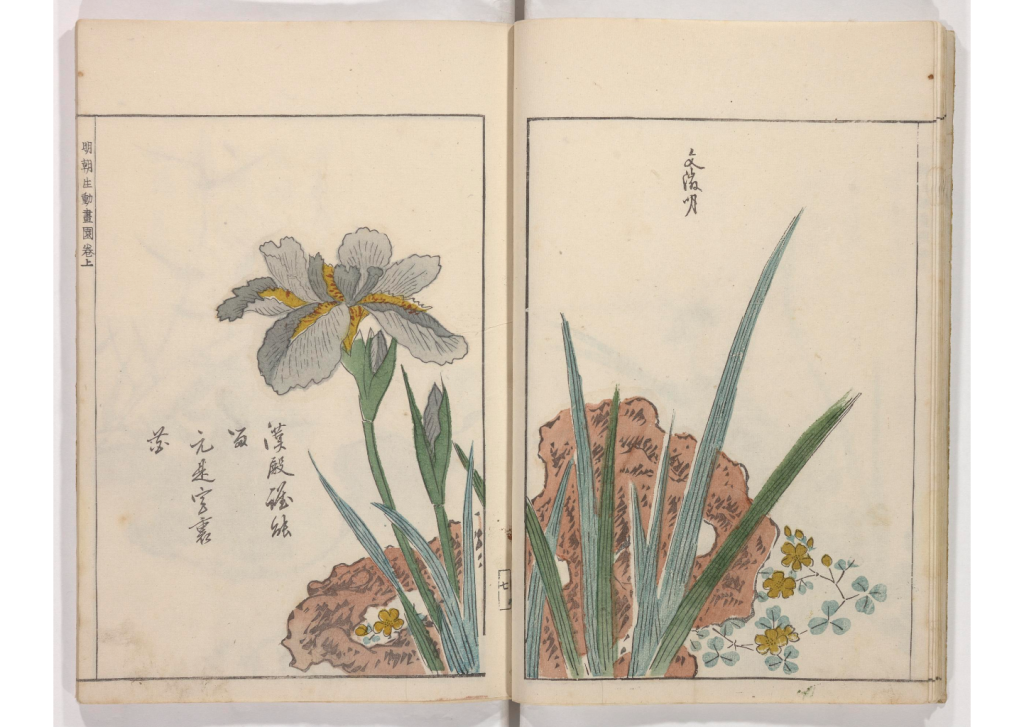
Minchō shiken 明朝紫硯 Artist: Ōoka Shunboku (1680–1763) Edo period, 1746 (Enkyō 3) Volume 1 of 3; kōkitoji binding; woodblock printed; stencil printed; ink and color on paper; paper covers 26.7 x 18.4 x 0.7 cm Freer Gallery of Art, FSC-GR-780.508.1-3

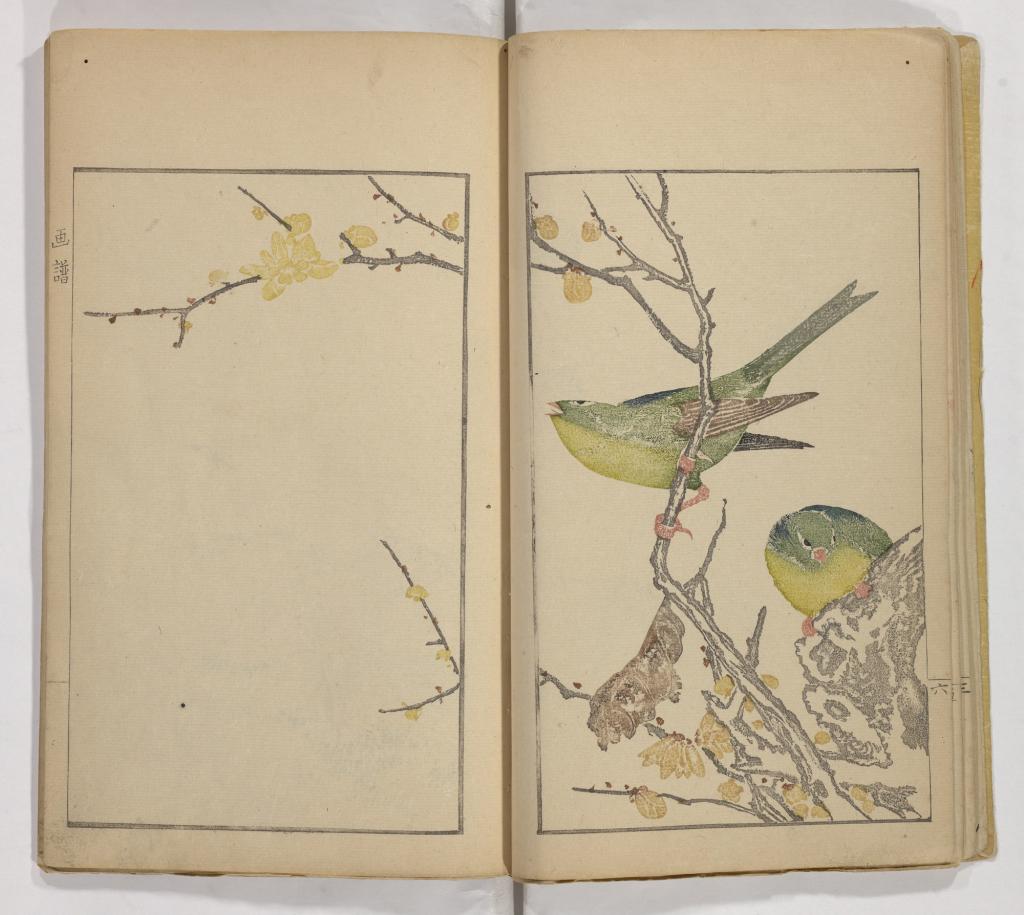
Sō Shiseki gafu 宋紫石画譜 Artist: Sō Shiseki (1712–1786) Edo period, 1765 (Meiwa 2) Volume 1 of 3; fukurotoji binding; woodblock printed; ink and color on paper; paper covers 27.1 x 16.7 x 0.6 cm Freer Gallery of Art, FSC-GR-780.546.1-3

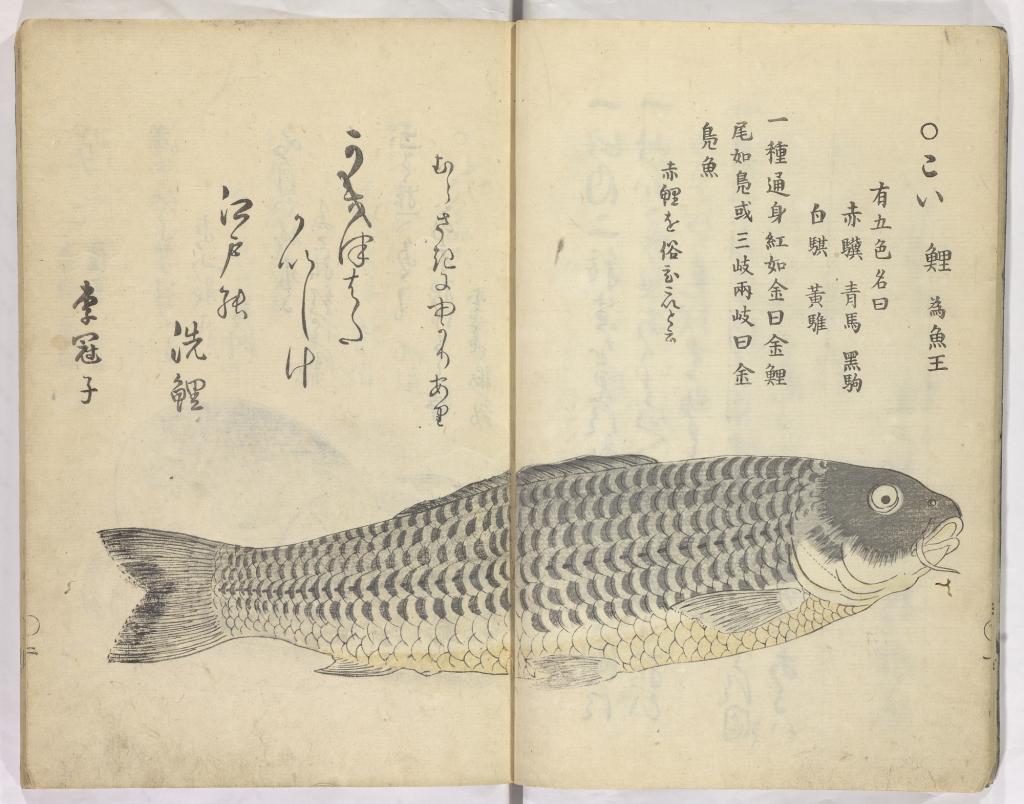
Umi no sachi 海幸 Artist: Katsuma Ryūsui (1711–1796) Edo period, 1762 (An’ei 7) Volume 1 of 2; fukurotoji binding; woodblock printed; ink and color on paper; paper covers 30 x 21 x 0.9 cm Freer Gallery of Art, FSC-GR-780.169.1-2
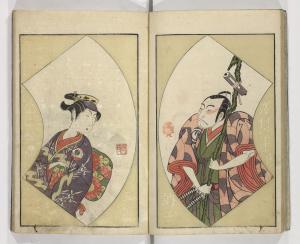
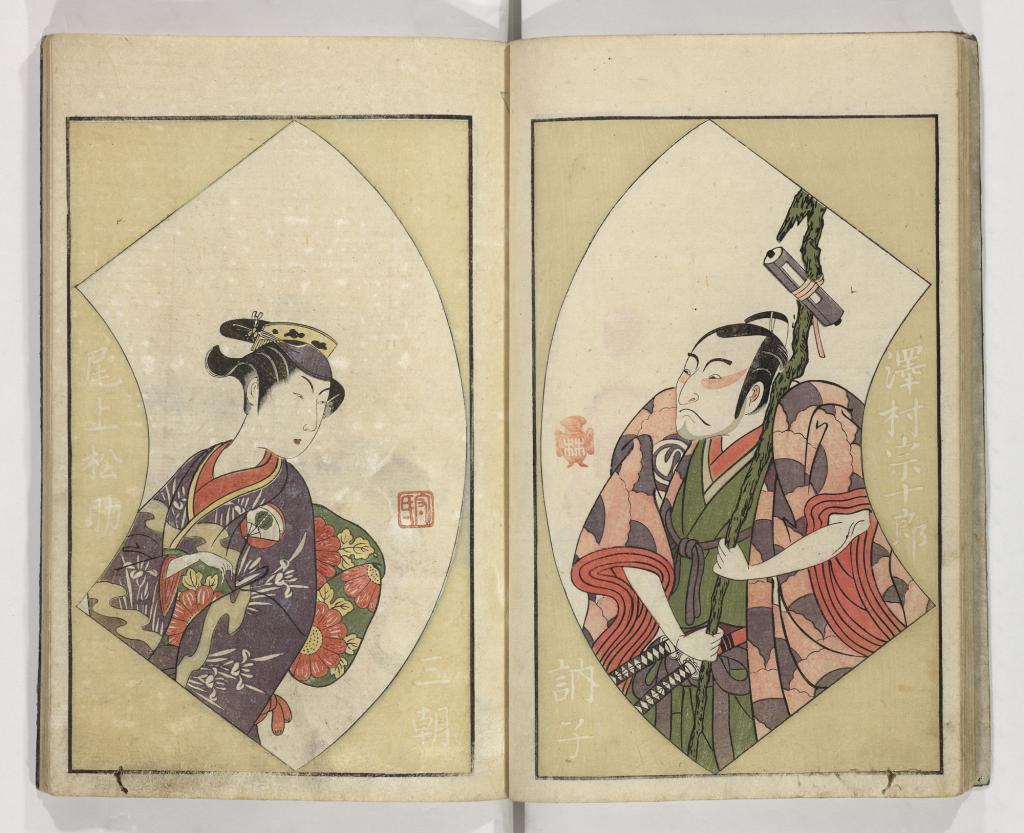
Ehon butai ōgi絵本舞台扇 Artists: Katsukawa Shunshō (1726–1792) and Ippitsusai Bunchō (active 1755–1790) Edo period, 1770 (Meiwa 7) Volume 2 of 3; fukurotoji binding; woodblock printed; ink and color on paper; paper covers 28.5 x 19 x 0.9 cm Freer Gallery of Art, FSC-GR-780.163.1-3/1917 facsimile printing FSC-GR-780.165.1-3
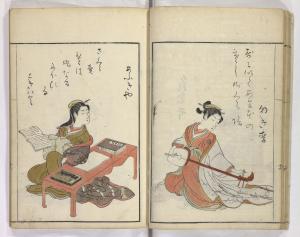

Ehon seirō bijin awase 絵本青楼美人合 Artist: Suzuki Harunobu (1724–1770) Edo period, 1770 (Meiwa 7) Volume 1 of 4; fukurotoji binding; woodblock printed; ink and color on paper; paper covers 26.7 x 18.7 x 0.8 cm Freer Gallery of Art, FSC-GR-780.558.1-5

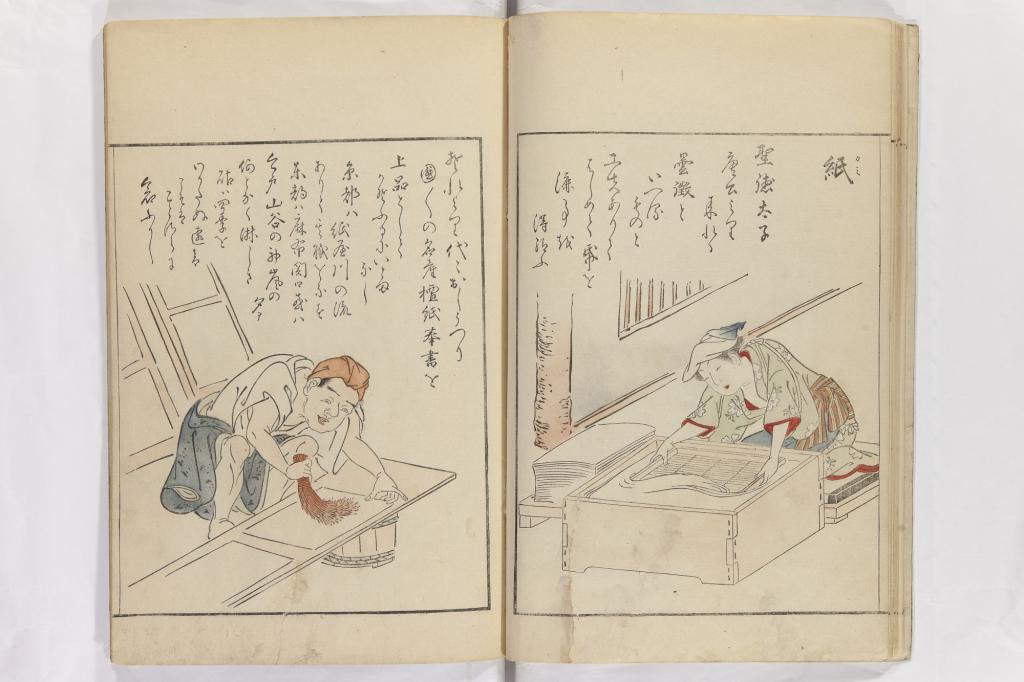
Shokunin burui 職人部類 Artist: Tachibana Minkō (active 1751–1771) Edo period, undated 1 volume; fukurotoji binding; woodblock printed; ink and color on paper; paper covers 28.2 x 19.2 x 0.7 cm Freer Gallery of Art, FSC-GR-780.566
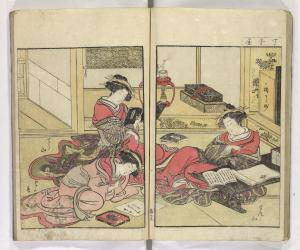
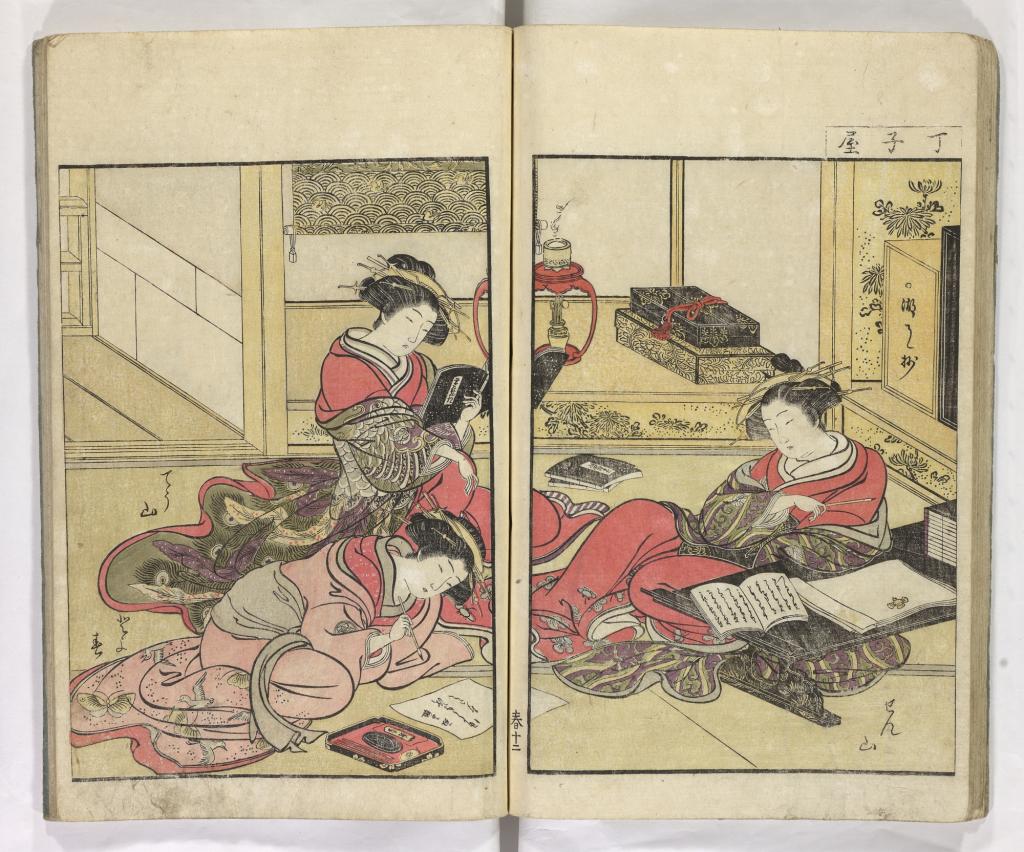
Seirō bijin awase sugata kagami 青楼美人合姿鏡 Artists: Katsukawa Shunshō (1726–1792) and Kitao Shigemasa (1739–1820) Edo period, 1776 (An’ei 5) Volume 1 of 3; fukurotoji binding; woodblock printed; ink and color on paper; paper covers 7.9 x 18.6 x 0.7 cm Freer Gallery of Art, FSC-GR-780.167.1-3
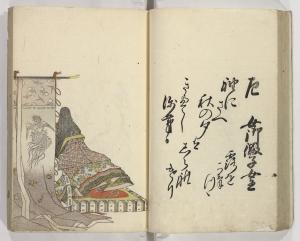
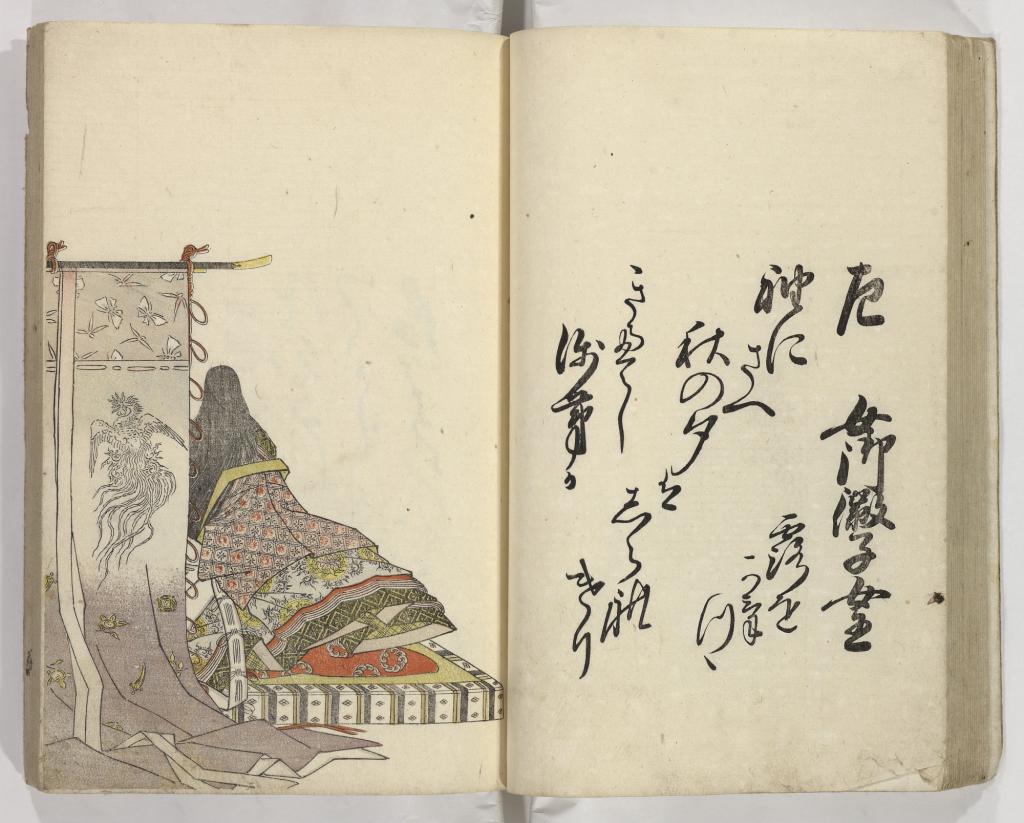
Sanjūrokkasen 三十六歌仙 Artist: Katsukawa Shunshō (1726–1792) Edo period, 1789 (Tenmei 9) 1 volume; fukurotoji binding; woodblock printed; ink and color on paper; paper covers 29.6 x 20.6 x 2.3 cm Freer Gallery of Art, FSC-GR-780.162
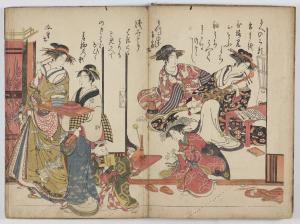
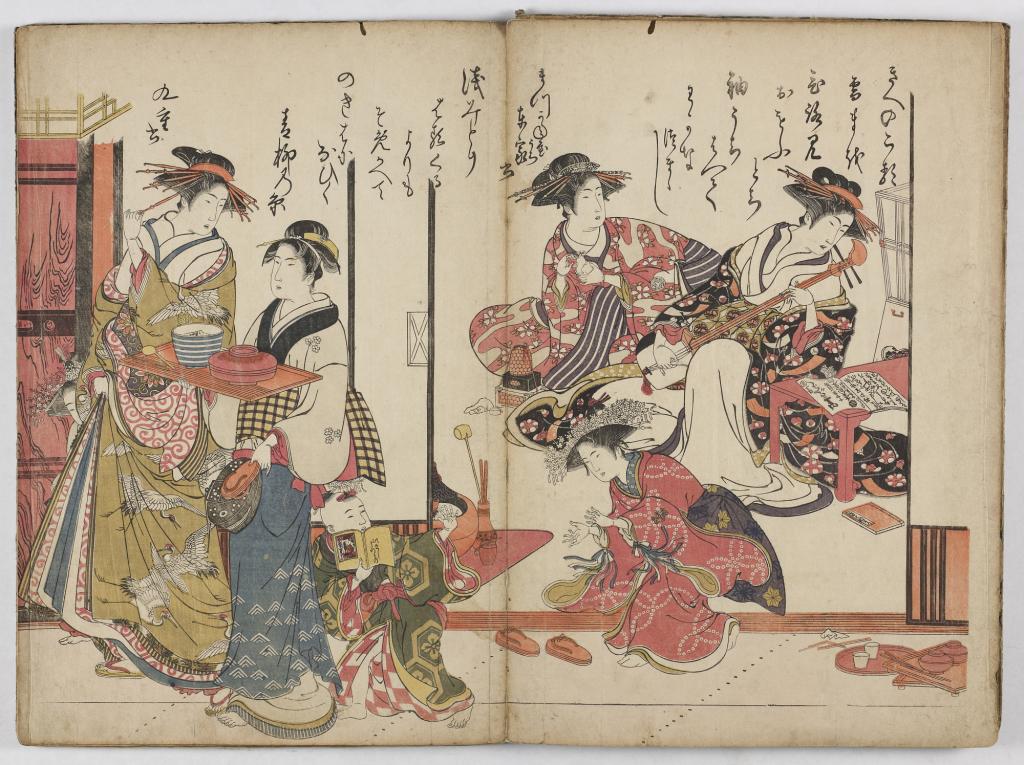
Shin bijin awase jihitsu kagami新美人合自筆鏡 Artist: Kitao Masanobu (1761–1816) Edo period, 1784 (Tenmei 4) 1 volume; gajōsō binding; woodblock printed; ink and color on paper; paper covers 37.9 x 25.9 x 1.1 cm Freer Gallery of Art, FSC-GR-780.330

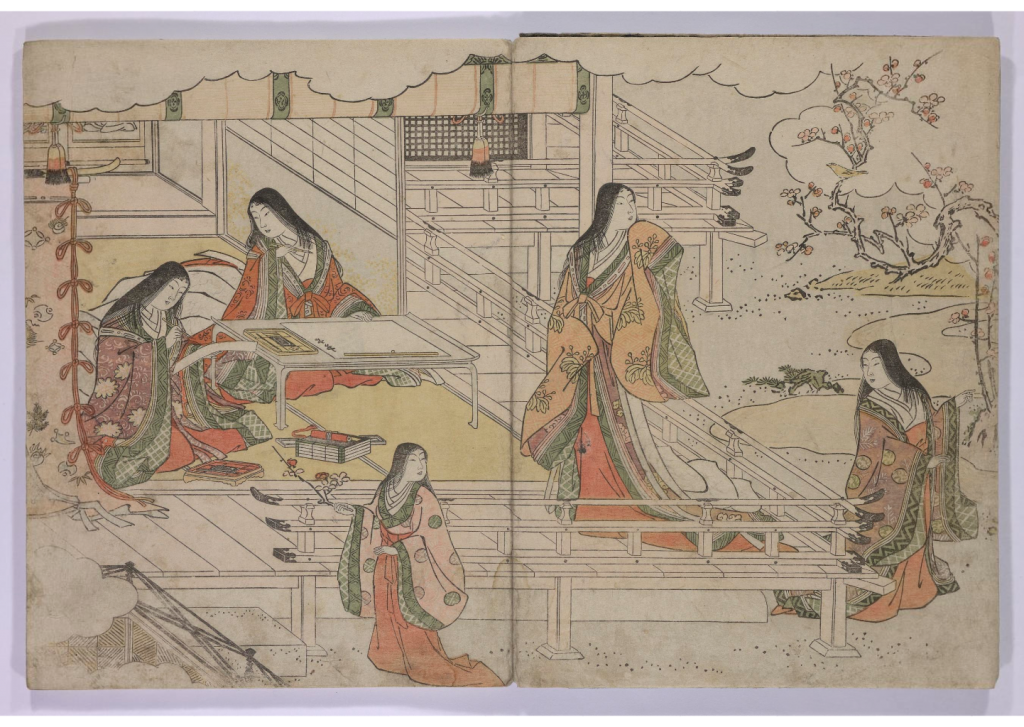
Saishiki mitsu no asa彩色美津朝Artist: Torii Kiyonaga (1752–1815) Edo period, 1787 (Tenmei 7) 1 volume; gajōsō binding; woodblock printed; ink and color on paper; paper covers 25.2 x 19.1 x 0.8 cm Freer Gallery of Art, FSC-GR-780.618
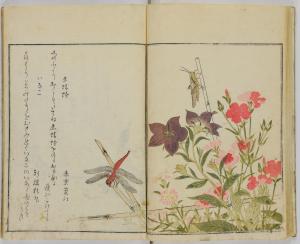
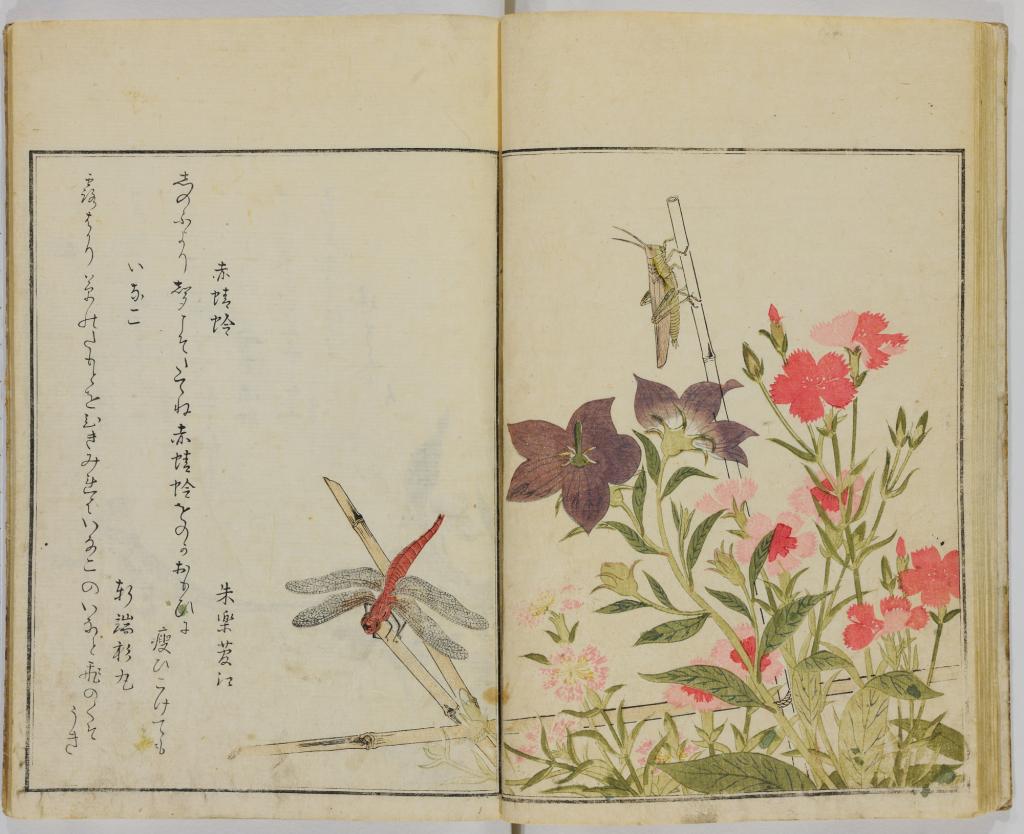
Ehon mushi erami絵本虫えらみArtist: Kitagawa Utamaro (1753–1806) Edo period, 1788 (Tenmei 8) 1 volume; fukurotoji binding; woodblock printed; ink and color on paper; paper covers 27.3 x 18.2 x 0.9 cm Freer Gallery of Art, FSC-GR-780.321.1-2

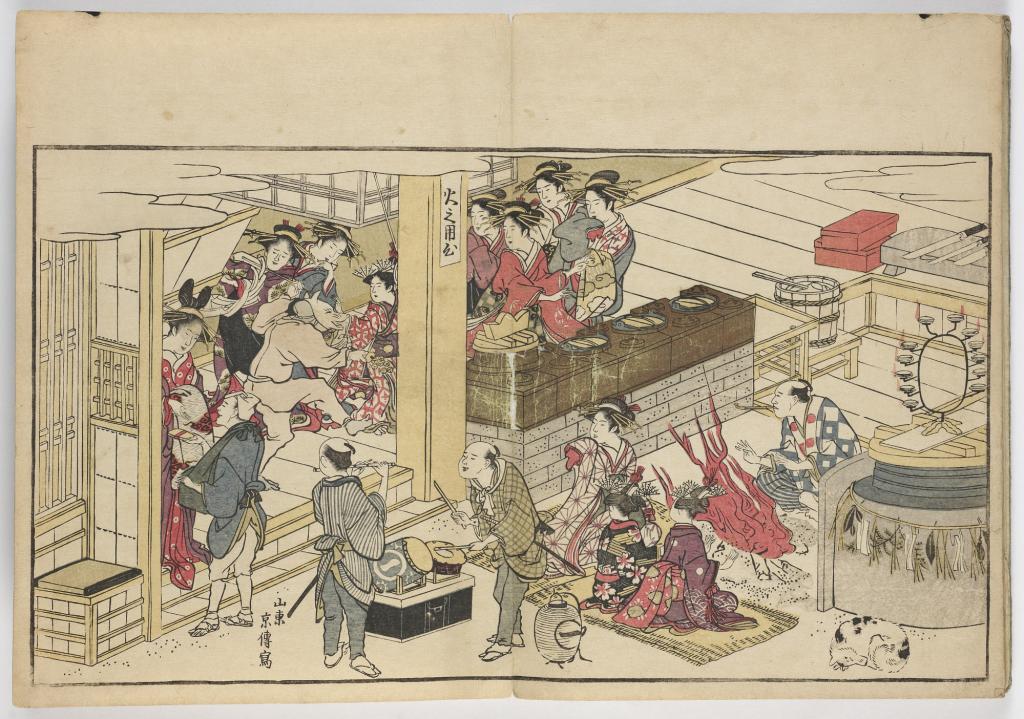
Yomo no haru四方の巴流Artists: various Edo period, 1789 (Kansei 7) 1 volume; gajōsō binding; woodblock printed; ink and color on paper; paper covers 22.2 x 16.1 x 1.5 cm Freer Gallery of Art, FSC-GR-780.849.1-2
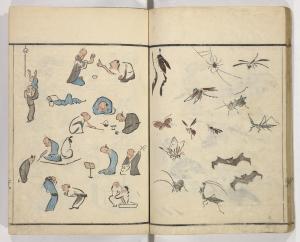

Ryakuga shiki略画式Artist: Kitao Masayoshi (1764–1824) Edo period, 1795 (Kansei 7) 1 volume; fukurotoji binding; woodblock printed; ink and color on paper; paper covers 26.4 x 18.1 x 0.9 cm Freer Gallery of Art, FSC-GR-780.335
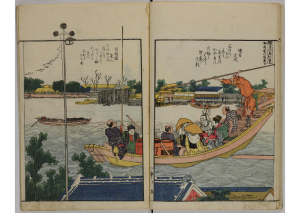
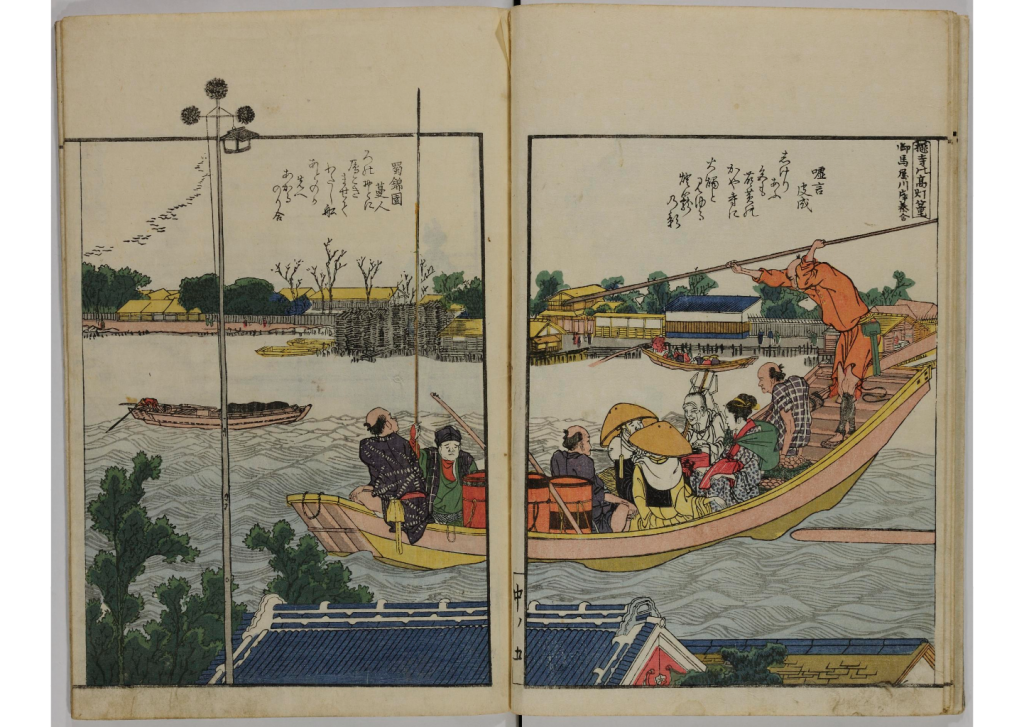
Ehon Sumidagawa ryōgan ichiran 絵本隅田川両岸一覧 Artist: Katsushika Hokusai (1760–1849) Edo period, undated (circa 1805) Volume 2 of 3; fukurotoji binding; woodblock printed; ink and color on paper; paper covers Freer Gallery of Art, 26.5 x 18.3 x 0.4 cm FSC-GR-780.230.1-3
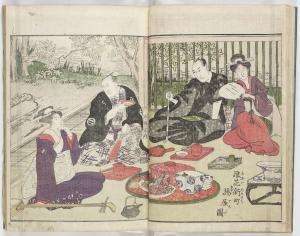
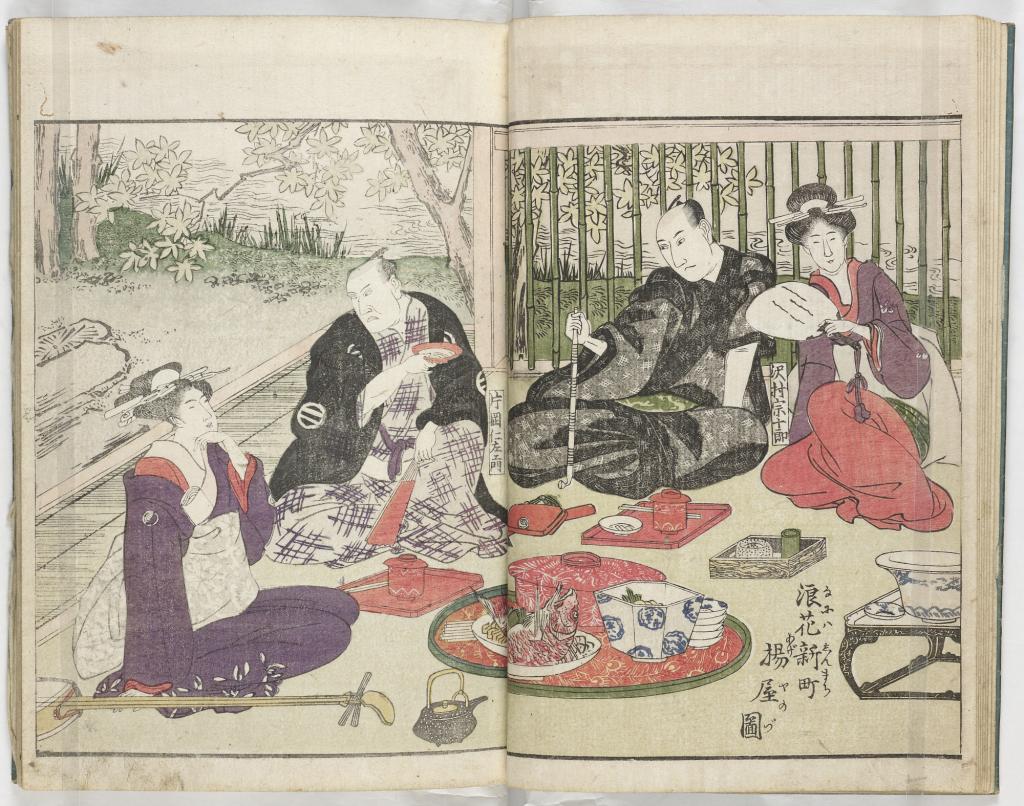
Yakusha sangaikyō俳優三階興Artist: Utagawa Toyokuni (1769–1825) Edo period, 1801 (Kansei 13) Volume 2 of 2; fukurotoji binding; woodblock printed; ink and color on paper; paper covers 21.9 x 15.5 x 0.9 cm Freer Gallery of Art, FSC-GR-780.741.1-2
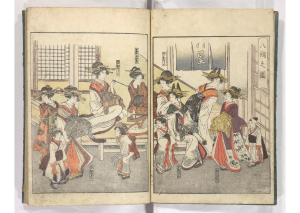
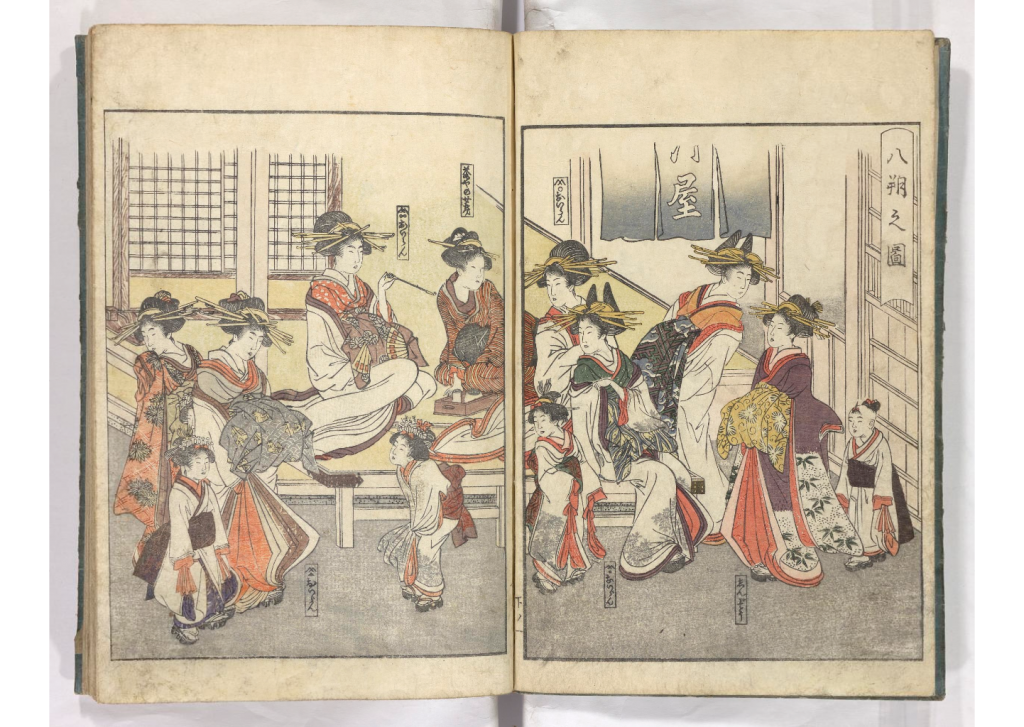
Seirō ehon nenjū gyōji青楼絵本年中行事 Artist: Kitagawa Utamaro (1753 –1806) Edo period, 1804 (Kyōwa 4) Volume 2 of 2; fukurotoji binding; woodblock printed; ink and color on paper; paper covers 22.7 x 15.9 x 1 cm Freer Gallery of Art, FSC-GR-780.327.1-2
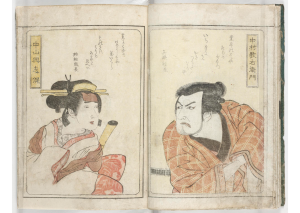
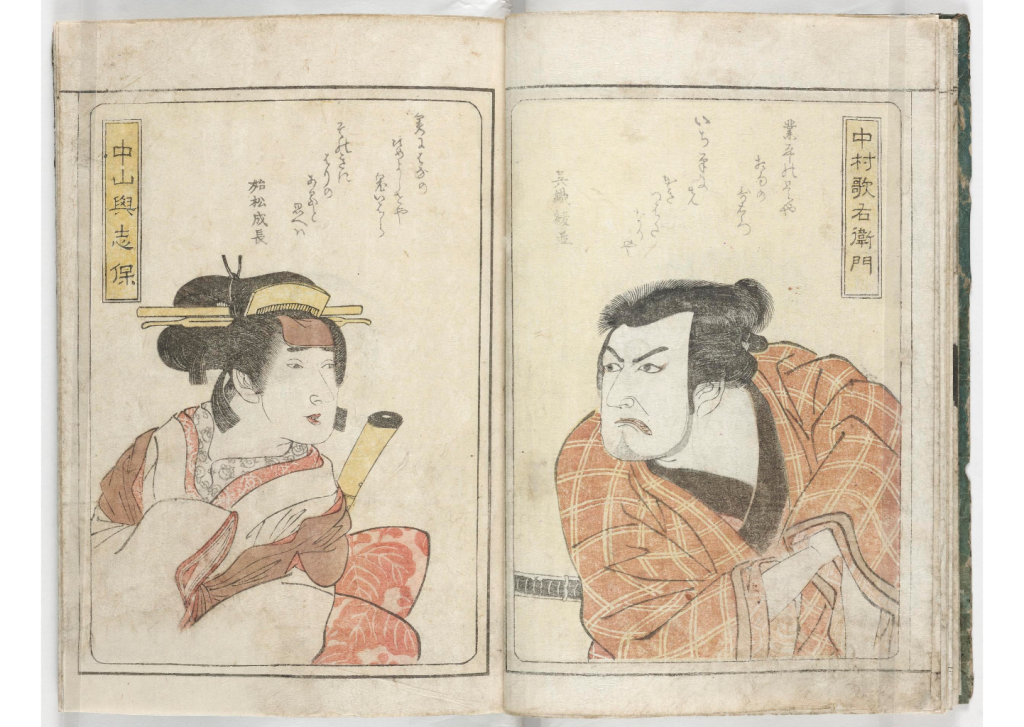
Masu kagami ■須可我美 Artist: Shōkōsai Hanbē (active 1795–1807) Edo period, 1806 (Bunka 3) 1 volume; fukurotoji binding; woodblock printed; ink and color on paper; paper covers 20.3 x 14.7 x 0.5 cm Freer Gallery of Art, FSC-GR-780.798
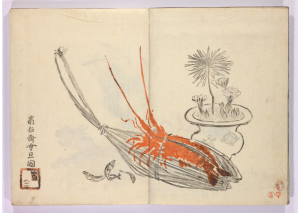
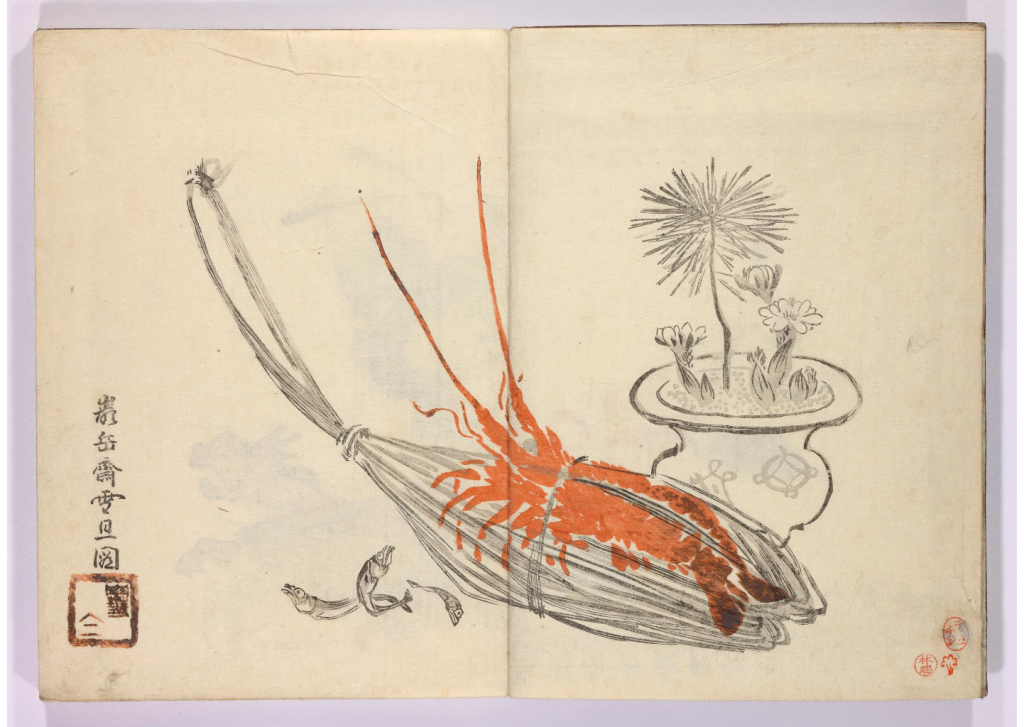
Koga yōran古画要覧 Artist: Hasegawa Settan (1778–1843) Edo period, 1812 (Bunka 9) 1 volume; gajōsō binding; woodblock printed; ink and color on paper; paper covers 22.8 x 16.1 x 0.9 cm Freer Gallery of Art, FSC-GR-780.70
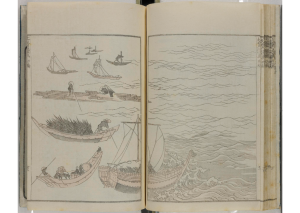
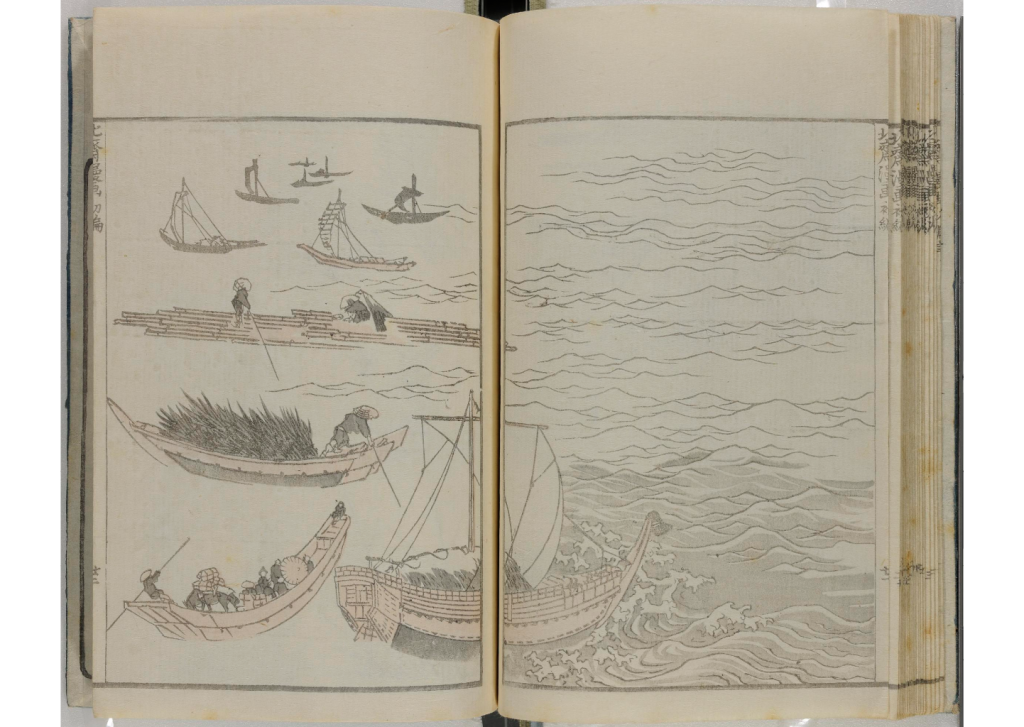
Hokusai manga北斎漫画 Artist: Katsushika Hokusai (1760–1849) Edo–Meiji periods, 1814 (Bunka 11)–1878 (Meiji 11) Volume 1 of 14; fukurotoji binding; woodblock printed; ink and color on paper (vol. 12, ink on paper); paper covers 22.9 x 15.9 x 1 cm Freer Gallery of Art, FSC-GR-780.233.1-14
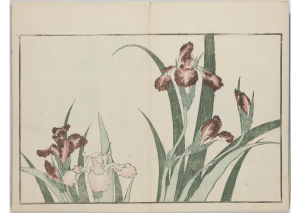
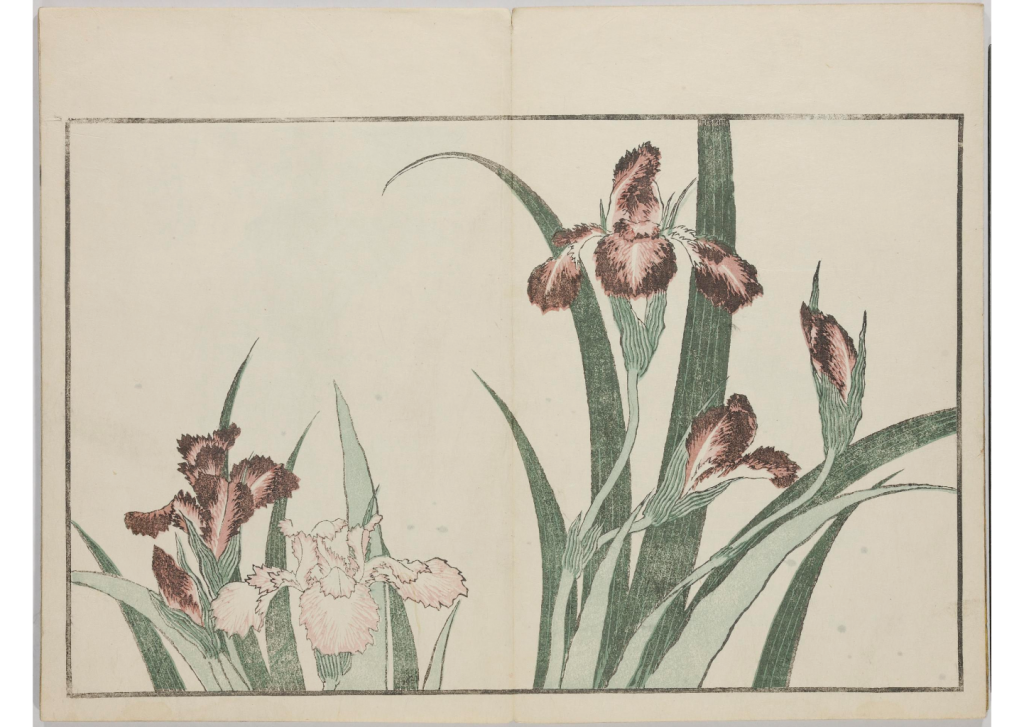
Hokusai shashin gafu北斎写真画譜Artist: Katsushika Hokusai (1760–1849) Edo period, 1814 (Bunka 11) 1 volume; gajōsō binding; woodblock printed, embossing; ink and color on paper; paper covers 25.7 x 17 x 0.8 cm Freer Gallery of Art, FSC-GR-780.237
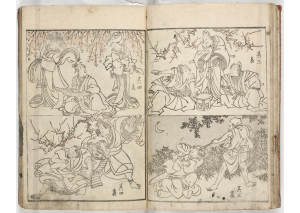

Yakusha nigao haya geiko役者似顔早稽古Artist: Utagawa Toyokuni I (1769–1825) Edo period, 1817 (Bunka 14) 1 volume; fukurotoji binding; woodblock printed; ink and color on paper; paper covers 18.5 x 13.1 x 1 cm Freer Gallery of Art, FSC-GR-780.745
